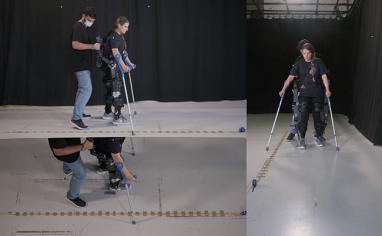SEE ENGLISH BELOW
O projeto Thermotactile feedback for improved exoskeleton control (Thertact-FB), desenvolvido pelos investigadores Carla Pais-Vieira, do Brain-Machine Interface Research Lab (BMIsLab) do Centro de Investigação Interdisciplinar em Saúde (CIIS) do Instituto de Ciências da Saúde (ICS), e André Perrotta, do Centro de Investigação em Ciência e Tecnologia das Artes (CITAR) – Escola das Artes, foi financiado no âmbito das bolsas EUROBENCH, ao abrigo do programa H2020.

Este projeto – realizado em colaboração com a Universidade de Aveiro e com a empresa de exoesqueletos ExoAtlet (Luxembourg) - visa contribuir para se estabelecer no espaço europeu, os critérios para benchmarking de exoesqueletos e de robôs humanoides. Neste projeto, pessoas saudáveis irão utilizar um exosqueleto robótico para membros inferiores em cenários que testam as potencialidades do exosqueleto em situações “reais”, tais como subir e descer degraus, ou caminhar em terrenos com diferentes inclinações e irregularidades. A realização de testes nestas condições permitirá determinar até que ponto os atuais exosqueletos e robôs humanoides estão ou não preparados para uma utilização mais generalizada a nível dos serviços de saúde, da indústria, e mesmo no quotidiano do cidadão comum.
The project Thermotactile feedback for improved exoskeleton control (Thertact-FB), developed by the researchers Carla Pais-Vieira, Brain-Machine Interface Research Lab (BMIsLab) at CIIS at Instituto de Ciências da Saúde (ICS), and André Perrotta, researcher at the CResearch Center for Science and Technology of the Arts (CITAR) – School of Arts, received funding in the context of the EUROBENCH grants, part of the H2020 program.
This project – developed in collaboration with the University of Aveiro and with the exoskeletons company ExoAtlet (Luxembourg) - intends to contribute to the establishment of benchmarking criteria in the field of exoskeletons and humanoid robots, in the european space. In this project, healthy people will use a robotic exoskeleton in their lower limbs in scenarios that test the potentiality of the exoskeleton in "real" situations, such as climbing up and down stairs, or walk in uneven and irregular grounds. The undertaking of tests under these conditions will allow to determinate if the current exoskeletons and humanoid robots are prepared, or not, for a broader usage in health services, industry, and even in the daily life of the common citizens.





